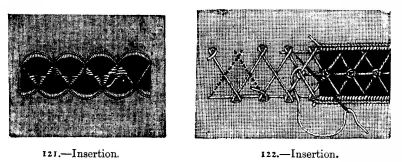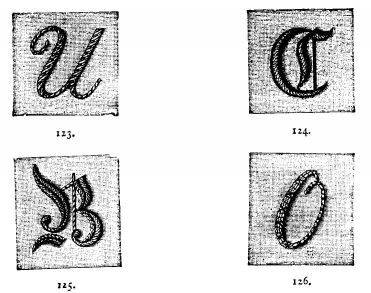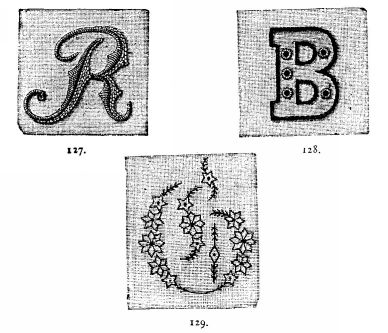Beeton's Book of Needlework | Embroidery Instructions
EMBROIDERY INSTRUCTIONS
The art of embroidering with cotton on linen, muslin, cambric, piqué, &c.c., is very easy to learn by strictly attending to the following instructions.
The size of the thread and needle must correspond to that of the material on which you embroider; the needle must not be too long, and the cotton must be soft. Messrs. Walter Evans and Co.'s embroidery cotton is the best. Skilful embroiderers never work over anything, because when you tack the material on paper or cloth each stitch shows, and if the material is very fine, leaves small holes; but for those that are learning we should advise them to tack the material to be embroidered upon a piece of toile cirée. If you work without this, place the material straight over the forefinger of the left hand; the material must never be held slantways. The three other fingers of the left hand hold the work; the thumb remains free to give the right position to each stitch. The work must always, if possible, lie so that the outline of the pattern is turned towards the person who works. For the sake of greater clearness one part of the following illustrations is given in larger size than nature. Preparing the patterns is one of the most important things in embroidery, for the shape of the patterns is often spoiled merely because they have not been prepared with sufficient care.

ILLUSTRATION 66 shows how to prepare a scallop. Take thicker cotton than that with which you work; never commence with a knot, and do not take a thread longer than sixteen or eighteen inches. The outlines of the scallops are first traced with short straight stitches. In the corners particularly the stitches must be short. The space between the outlines is filled with chain stitches, as can be seen from illustration; they must not be too long, otherwise the embroidery will look coarse. It is in this way that every pattern to be worked in button-hole or satin stitch is to be prepared.

ILLUSTRATION 67 shows the double overcast stitch or button-hole stitch in a straight line. After having traced the outline begin to work from left to right; fasten the cotton with a few stitches, hold it with the thumb of the left hand under the outline, insert the needle downwards above the outline, draw it out under the same above the cotton which you hold in the left hand, and draw it up. Repeat for all the stitches in the same manner; they must be regular and lie close to one another. Great care should be taken that the material on which you embroider is not puckered.

ILLUSTRATION 68 (Overcast Stitch).--The double overcast and the button-hole stitches are worked from left to right, whilst back stitches, knotted and satin stitches are worked from right to left. The stitch is worked in the same way as the double overcast, only the needle must never be drawn out above, but below, the cotton with which you work, and which you keep down with the thumb of the left hand.

ILLUSTRATION 69.--The slanting overcast stitch is worked without tracing the outline, always inserting the needle downwards--that is, from top to bottom. The needle must be inserted in the manner shown in illustration--that is, not straight, but slanting; insert it a little farther than the last stitch, and draw it out close to it. The wrong side of the work must show back stitches. This sort of stitch is used for the fine outlines in patterns or letter.

ILLUSTRATION 70.--This shows the back stitch, the working of which is well known; it is worked in several rows close to each other.


ILLUSTRATIONS 71 & 72 show another kind of back stitch, called point croisé, which is only used on very thin and transparent materials. This stitch forms on the wrong side a sort of darned pattern, which is seen by transparence on the right side, and gives the embroidered pattern a thicker appearance, contrasting with the rest of the work (see the lower leaves of the flower on illustration 110). For this stitch insert the needle into the material as for the common back stitch, draw it out underneath the needle on the opposite outline of the pattern, so as to form on the wrong side a slanting line. Insert the needle again as for common back stitch; draw it out slanting at the place marked for the next stitch on the opposite outline, as shown in illustration 71.

ILLUSTRATION 73 shows the knotted stitch; the simplest way of working it is to work two back stitches at a short distance from each other over the same thread.
The knotted stitch seen in ILLUSTRATION 74 is worked thus:--Take about four threads of the material on the needle, draw the needle half out, wind the cotton twice round the point of the needle, hold it tight with the thumb, draw the needle out carefully and insert it at the place where the stitch was begun, and draw it out at the place where the next stitch is to be worked.


The knotted stitch seen on ILLUSTRATION 75 is worked in nearly the same manner as the preceding one. Before drawing the cotton out of the material hold it tight with the left-hand thumb; leave the needle in the same position, wind the cotton twice round it, turn the needle from left to right, so (follow the direction of the arrow) that its point arrives where the cotton was drawn out (marked by a cross in illustration), insert the needle there, and draw it out at the place of the next stitch.

ILLUSTRATIONS 76 & 77.--Raised satin stitch is principally used for blossoms, flowers, leaves, letters, &c.c. After having traced the outlines of the pattern, fill the space left between them with chain stitches in a direction different from that in which the pattern is to be embroidered; begin at the point of the leaf, working from right to left, make short straight stitches, always inserting the needle close above the outline and drawing it out below. The leaves on the flowers, as well as on the branches, must be begun from the point, because they thus acquire a better shape. If you wish to work a leaf divided in the middle, as seen in illustration 77, you must trace the veining before you fill it with chain stitches, then begin at one point of the leaf and work first one half and then the other.


ILLUSTRATION 78 shows the so-called point de plume on a scalloped leaf. It is worked like the satin stitch, only the needle is drawn through the material in a slanting direction.

ILLUSTRATION 79 (Point de Minute).--This stitch is often used instead of satin stitch when the patterns must appear raised. Wind the cotton several times round the point of the needle, which is inserted into the material half its length (the number of times the cotton is to be wound round the needle depends on the length of the pattern), hold fast the windings with the thumb of the left hand, draw the needle and the cotton through the windings, insert the needle into the material at the same place, and draw it out at the place where the next stitch is to begin.


ILLUSTRATIONS 80 & 81 show the ladder stitch, often used in ornamental embroidery. Trace first the outlines as seen in illustrations; mark also the cross stitches between the outlines, so that the first touch the outlines only at both ends. The outlines are embroidered in overcast stitch or double overcast; the material is cut away underneath the ladder stitch between the outlines.
We have now shown the different kinds of stitches used in embroidery; the following illustrations show them used for different patterns.




ILLUSTRATIONS 82 TO 85 (Different Button-hole Stitch Scallops).--These scallops are prepared as above described. Take care to have the stitches even and regular; the scallops must be wide in the centre and very fine at both ends.
ILLUSTRATIONS 86 & 87 (Button-holes and Eyelets).--This kind of embroidery is used only in round or long patterns. Trace first the outline of the hole, cut away a small round piece of material, not too close to the outlines (when the button-hole is very small merely insert the point of the scissors or a stiletto into the material), fold the edge of the material back with the needle, and work the hole in overcast stitch, inserting the needle into the empty place in the centre and drawing it out under the outline. Some button-holes are worked separately; sometimes they are in a row; if so, take care to begin to work each button-hole at the place where it touches the next. In the following button-holes the outside must be traced double, so as to reach as far as the next one, but each button-hole is finished at once. Illustration 86 shows a button-hole worked round in button-hole stitch, 87 an eyelet-hole worked in overcast.




ILLUSTRATIONS 88 & 89.--Shaded button-holes are worked like the others, only they are prepared, as can be seen in illustration 89, so as to mark the thickness. The stitches must gradually get narrower or wider, and be worked very close to each other.

ILLUSTRATIONS 90 & 91 (Two Leaves in Raised Satin Stitch).--In a leaf like the one seen in 90 work first the outline and veining in overcast stitch; work one half of the leaf in satin stitch, and the other half between the overcast outline and veining in back stitch. The stem of a leaf is always worked last.


ILLUSTRATIONS 92 & 93 (Two Leaves in Satin Stitch and Point de Plume).--For leaves like the one seen in 93 begin with the veinings, then work the inner points, then the outer ones, and lastly the raised spots in the centre. The leaf seen in 92 is worked, one half in point de plume, the other half in back stitch or point d'or.


ILLUSTRATION 94.--- The outline of this leaf is embroidered in overcast stitch; the open-work veining consists of eyelets; one half of the leaf is worked in back stitch, the other half in a kind of satin stitch worked without chain stitches underneath; the stitches are worked across the leaf, leaving between two stitches an interval as wide as the stitch itself. The next row is then worked in these intervals, and each stitch begins half-way up the one before and after it.



ILLUSTRATIONS 95 to 97 (Leaf in Raised Embroidery).--This kind of embroidery is particularly beautiful, as it is worked separately and sewn on the material with an outline in very fine cotton, this produces the shade seen in 95 (see also illustrations 98 to 113). For such leaves work first one half in overcast and satin stitch (illustration 96); the other half is worked on a separate piece of material (see illustration 97); cut away the material along the overcast outline, and fasten it on the foundation material along the outline which forms the veining on illustration 96.



ILLUSTRATIONS 98 TO 100 show a similar leaf; both halves are worked separately (see 99); the centre is worked in open lace stitch. The latter (see No. 100) is traced, then make ladder stitches across, work the outlines in overcast stitch, and cut away the material underneath the ladder stitch. The cross stitches are then worked in darning stitch with very fine cotton wherever two threads meet.

ILLUSTRATION 101 (Blossom in Satin Stitch).--The eyelet is worked in overcast stitch, then work the upper part of the blossom all in one piece as far as the beginning of the veining, thence the blossom is worked in two halves.


ILLUSTRATIONS 102 & 103 (Blossom in Satin Stitch).--The raised centre of this flower is formed by a bead, over which the embroidery is worked. When the leaves have been worked one after the other, place a bead in the centre, left free in such a manner that one hole lies on the material, and work over the bead by inserting the needle into its upper hole, then underneath the material, drawing it out above the material close to the bead, and so on (see 103).

ILLUSTRATION 104 (Star Pattern in Satin Stitch).--The centre, which forms a wheel, is worked first. Draw the threads across the circle marked by an outline; in the centre they are wound round, always taking one thread on the needleand leaving the next thread under the needle, as can be seen in 122 on the half-finished pattern. The material underneath the wheel is only cut away when the rest of the pattern has been embroidered.

ILLUSTRATIONS 105 & 106 (Patterns in Back, Satin, and Ladder Stitches).--The small star in the centre of No. 105 is worked in point de reprise.


ILLUSTRATION 107 (Flower in Satin Stitch).--The fine veinings are worked with fine black silk in point russe, which renders the effect of the flower very beautiful.


ILLUSTRATIONS 108 & 109 (Rose in Satin Stitch).--No. 109 shows one petal larger than full size. The outer circle only is prepared with chain stitches underneath, so as to appear raised; the inner circles are worked flat. The centre of the rose is embroidered in open work.

ILLUSTRATION 110 (Embroidered Heartsease).--For the knotted stitch see No. 75. for the point croisé see 71 and 72.

ILLUSTRATION 111 (Flower in Raised Satin Stitch).

ILLUSTRATION 112 (An Ear of Corn in Point de Minute).


ILLUSTRATIONS 113, 114, & 116 (Bluebell in Raised Satin Stitch).--This flower is worked partly in separate pieces, as has been described. Illustration 116 shows the raised part stretched out flat. When it is finished it is fastened down along the dotted line on No. 114, which shows the inner part of the flower.

ILLUSTRATION 115 (Flower in Point de Minute).--This stitch is here worked over a thick foundation of chain stitches. For raised patterns it looks very well.


ILLUSTRATIONS 116 & 117 (Flower worked in Appliqué).--To work in appliqué, two materials, either similar or different, are needed. You can work either in appliqué of muslin on muslin, or of muslin on net, or of net on net. Muslin on Brussels net is the prettiest way of working in appliqué; we will therefore describe it: the other materials are worked in the same manner. Trace the pattern on the muslin, fasten the latter on the net, and trace the outlines of the pattern with very small stitches work them in overcast stitch with very fine cotton, taking care not to pucker the material. The veinings are worked in overcast. When the pattern has been embroidered cut away the muslin round the outlines with sharp scissors, so that the net forms the grounding (see No. 117). The greatest care is required in cutting out the muslin to avoid touching the threads of the net.

ILLUSTRATIONS 118 & 119 (Narrow Borders).--It will be easy to work these borders from the above instructions. Observe only that on border 118 the outer row of scallops is worked first, then the button-hole stitch row, and the rest afterwards. The spots are edged all round in knotted stitch. The wheels in the centre of the eyelets of No. 119 are worked with very fine cotton in loose button-hole stitch; they are wound round with the cotton in a second row.


ILLUSTRATIONS 120 TO 122.--Three strips of insertion, which are worked nearly like the ladder stitch. For No. 120, in tracing the outlines, make two small knots at short distances by winding the cotton four times round the needle, as can be seen in illustration; the windings are held down with the thumb of the left hand, draw the needle through, and a knot is formed. The outlines are worked in button-hole stitch only when all the knots have been made, and then the material is cut away underneath. Illustration 121 is a variety of the slanting ladder stitch.
Illustration 122.--The cross threads are worked in two rows in the common herring-bone stitch, as can be seen by the black lines on the illustration. The straight lines at the top and at the bottom are worked in double overcast; lastly, the wheels are worked in a row as described for the star pattern, No. 104.


ILLUSTRATIONS 123 To 129 (Embroidered Initials).--To learn to work initials the Roman characters are the easiest to begin with. They must be traced and prepared like other embroidery in satin stitch, only the chain stitches underneath must not be too thick: it would take away the shape of the letters. All depends on the fineness and regularity of the stitches; they must be worked in overcast stitch. Work from left to right, and the letter when completed must look rather like raised printing than like embroidery. Gothic letters are much more difficult to work on account of the many flourishes; it requires great practice in needlework to embroider them well.
Illustration 123.--The small black dots are worked in black silk on the thick parts of the letter: the fine strokes are covered with cross threads of black silk.
Illustration 124.--The outlines of the letter and the fine strokes are worked in black silk.
Illustration 125.--This letter is embroidered in raised satin stitch and point de plume.
Illustration 126.--This letter is worked in back stitches, over which are worked at regular distances cross stitches of black silk.
Illustration 127.--Letter in satin and back stitch.
Illustration 128 to be worked in overcast and double overcast.

ILLUSTRATION 129.--Letter G in point russe with black silk.

ILLUSTRATION 130 (Embroidered Figures).--They are worked like the letters in point de plume and overcast; the dots are worked in knotted stitch.
| Pattern Categories Browse the categories to help you find the patterns you're looking for. |
||







